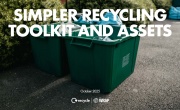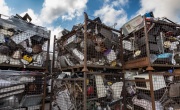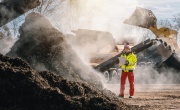How smart is recycling?
Will Simpson gets to grip with the latest developments in recycling software
Technology continues to rearrange every aspect of our lives, and like most industries, recycling and waste management has been transformed by IT and the sort of ‘can-they-really-do-that?’ software that just a decade ago would have been the fantasies of an intoxicated science fiction novelist.
Even within the last half decade, much has changed. Indeed, in a 2011 feature (see Resource 59) we looked at how IT had revolutionised the lot of the recycling officer. One of the major themes of the five years since has been that technological change has come to affect everyone who works in the service, right down to the humblest waste operative. Crucially, it has also allowed an awful lot of cost- reducing and efficiency saving, just at a time when local authorities are being squeezed financially as never before.
One of the authorities that has been hardest hit by cuts is Newcastle City Council. However, its waste services department has been greatly aided by new software, a three-part package called RouteSmart that incorporates the in-cab software Navigator and Fusion, which is used at the back office.
“It allows you to generate in digital form a map of the situation you want on the ground”, explains Sandy Twyholm, Lead Officer for Business Innovation. “Then you can have the option of either saying ‘Right okay, I want to be able to service this in this particular time – what resources do I need to do that?’ In other words, ‘How many vehicles and staff do I need?’
“Alternatively, you might say ‘Right, this is the number of vehicles I’ve got – how much time do I need on those vehicles to service what I need to service?’ Effectively, RouteSmart is a boiling pot in which you can throw in information about the network, the roads, type of vehicle, the numbers of vehicles. Then it will chew all that up, balance it out and give you an efficiency plan.”
Newcastle purchased RouteSmart five years ago, and the package provided the information it needed to be able to make the decision to switch from a weekly to a fortnightly collection, thus saving in fuel and CO2 emissions. But it’s also able to deal with short-term problems too. “You can build in health and safety variables”, says Twyholm. “For example, if there is an obstruction on the road that a vehicle cannot get through to collect bins. You can generate all sorts of scenarios and ‘what ifs?’ – What if we added a vehicle here? How much more can we do, how much less time will it take? It’s meant we’ve been able to improve the service using fewer resources.”
Not so long back, the coolest kids on the software block were the Environment Agency’s WRATE tool, a lifecycle model that enabled local authorities to analyse a waste management system in its entirety and the Waste & Resources Action Programme (WRAP) Kerbside Analysis Tool, which scrutinised the variables within household collections. Both are still operational and still used by many councils, but have been superseded or at least complemented by a new wave of software that has emerged in the last half decade.
RouteSmart is typical of this new generation. “The big improvements we’ve seen in the last few years have been around the real-time access to data”, says Mark Garvey, the CEO of Whitespace Waste Software, a firm that specialises in providing packages for the sector. “The public these days want to be able to access information regarding their waste collections in formats that they are used to dealing with in other areas of their lives. For example, our package Power Suite allows you to publish that information within the local authority.
If you are waiting for your bins to be picked up at 8am and it gets to 8.05 and you wonder where they are, you can call up the local authority and go, ‘I want to check I haven’t missed the round.’ And this is built into the in-cab technology that gives the local authority the power to give the member of public a clear answer.
“The mobile tech has really developed hugely. The inside of a waste vehicle now is like a scene out of Star Trek. In the past, people would have to purchase a bespoke piece of in-cab kit. These days, with the advances in mobile phones, it has lowered the cost of those solutions hugely and also improved the amount of information that you can capture by increased data speed and improved tech quality. For instance, battery charge doesn’t just last an hour now – you can take it out for a whole day on a full charge.”
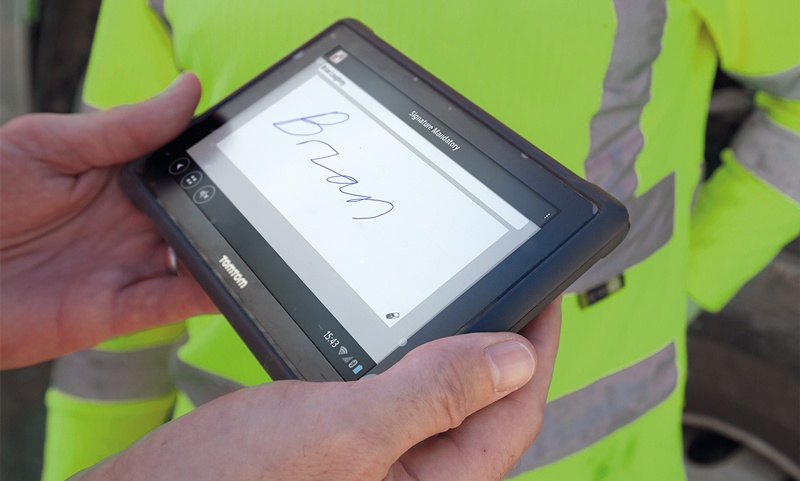
The other trend is towards software integration. When we spoke to Isys, a Derby-based software firm in 2011, it produced four different packages covering different aspects of the waste industry. Now those have been largely superseded by its new web-based mobile application, WeighSoft. “It caters for the whole of the waste and recycling industry”, explains Richard Bowers, Isys Managing Director. “Its applications cover everything whether that be paper, plastics, cardboard, bottling plants, energy-from-waste facilities... all of them control the flow of vehicles and waste data movement, basically.
“It’s increased the speed and efficiency from quote to job processing. We are not always printing paperwork now for the driver to take out with them; we’re delivering it directly to their mobile devices. It’s cutting out hours and hours of time. Drivers can just get in their cabs, complete their jobs and be able to receive their next job instructions all through their PDA or Android devices.”
It isn’t just the software that has allowed this, but better hardware. On the one hand, this has meant a proliferation of iPads and hand-held devices in the field, but in tandem with this has been a trend towards miniaturisation. “We’ve been through the whole process of rationalising all our server hardware”, explains Dave Gooding, Group IT Director of Biffa. “Indeed, we’ve actually virtualised a lot of our hardware, which means we’ve been able to massively reduce the carbon footprint of our IT department.
“We used to have 200 physical servers each the size of a small cupboard. All that has... been virtualised – now we have a server farm that has 20 physical servers that are the size of a small box each with all the rest being virtual servers. The next move is not to have any hardware at all. Our strategy now is cloud first. If any of the applications can be supported on the cloud, then we’ll do that first, because that gives you greater resilience, larger capability and greater speed.”
As one of the larger contractors, Biffa purchases software in a very different way to a smaller firm or local authority. The company has had its own central operating system since the early ’90s that controls all resource planning, management of assets and finances. “It’s a larger database- type system which we’ve developed ourselves and that was only really because there was really nothing else on the market at that time. It’s really helped us enormously – we’ve grown incredibly during that period and haven’t really had any issues with the scalability of the solution.”
To this central operating system, Biffa has added some of the new in-cab software solutions as well as its ‘Customer Zone’, which enables the company to interact with customers almost entirely digitally. The days of waiting for signatures and contracts being sent through the post are, for them, over.
However, Gooding does point out that even in this brave new world, both software and hardware are only as good as the training staff receive. Stories of operatives not using tech correctly or just ticking boxes to say all the houses on a particular round have been collected are common currency in the industry. “We’ve all heard them”, he admits. “I must say, though, at Biffa we have worked very hard over the last few years to invest in our processing system trainers – which was not even a role that we had before. But I can’t make a driver going out at 4am use his device – that has to be the local business manager. Management through the line and the right training is key.”
Much of what was predicted in the 2011 article – the increased web-based nature of software and importance of smart phone technology has come to pass. But what will things look like in another five years’ time? Much has been written about the ‘Internet of things’, the increasingly connective nature of, well, any tool you care to mention. Could we see more smart or ‘intelligent’ waste containers coming to a British high street soon?
This prospect was raised by a 2014 EU-funded report, ‘Intelligent Assets: Unlocking The Circular Economy Potential’, produced by the Ellen MacArthur Foundation. In it, a case study was produced about a prototype ‘intelligent’ waste system, BURBA (Bottom Up selection, collection and management of URBAn waste), that used RFID (radio frequency identification) and LBS (location-based system) technology. The technology would not only allow the municipality to optimise collection routes and measure data such as temperature, humidity, weight and volume of waste containers on demand or at specific points, such as disposal events, but would also connect individual users to the waste management system through their mobile phones, which would inform them of the most suitable container options when they are looking to dispose of waste. According to the report, the prototype system was ‘designed to increase the feasibility of optimising waste collection routing, reducing costs associated with fines on overflowing bins and incentivising certain waste disposal behaviour’.
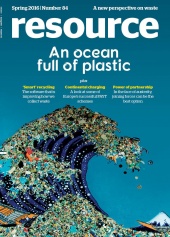 This article was taken from Issue 84
This article was taken from Issue 84However, in the final report, the prohibitive costs of scaling the prototype to municipal level were blamed for BURBA not being taken further – with specific concerns over the price of ‘smart’ bins, which can be up to 10 times the cost of traditional containers. Carolina Luano, one of the project’s coordinators, was disappointed. “The economic gap of manufacturing between a ‘normal’ waste container and an ‘intelligent’ one is high, mainly due to the IT infrastructure and mould design that would need to be developed.
“Will we see intelligent waste containers in the next 10 years? I don’t see why not. But it is important that the costs of the technologies are lowered and policy management is committed to investing in this field.”
Other commentators predict that existing trends towards miniaturisation and increased presence of mobile technology will continue. “In the next couple of years, 5G will be the next key driver”, says Garvey. “In reality, that will mean Wi-Fi speed but out in the field. Within five years, every truck is likely to be a Wi-Fi hotspot. There’ll be more connection, more communication between field workers and the back office than ever before.”
Then there are apps. Gooding says: “I was talking to a prospective client a while back, and he said, ‘Do you have an app that you can do everything on?’ We don’t have at the moment, but that’s the space where we want to be. As, I would guess, do many other companies.
“I think we’re likely to see that and the spread of smart technology across all areas of the industry. If you think of how much information is already captured on a truck – whether that’s the engine management system, the GPS coordinates, the fuel management of that truck, driver behaviour... as costs come down, our ability to track and retrieve even more information will only increase. It really is an exciting time.”
Best boot up and hold on tight. 


